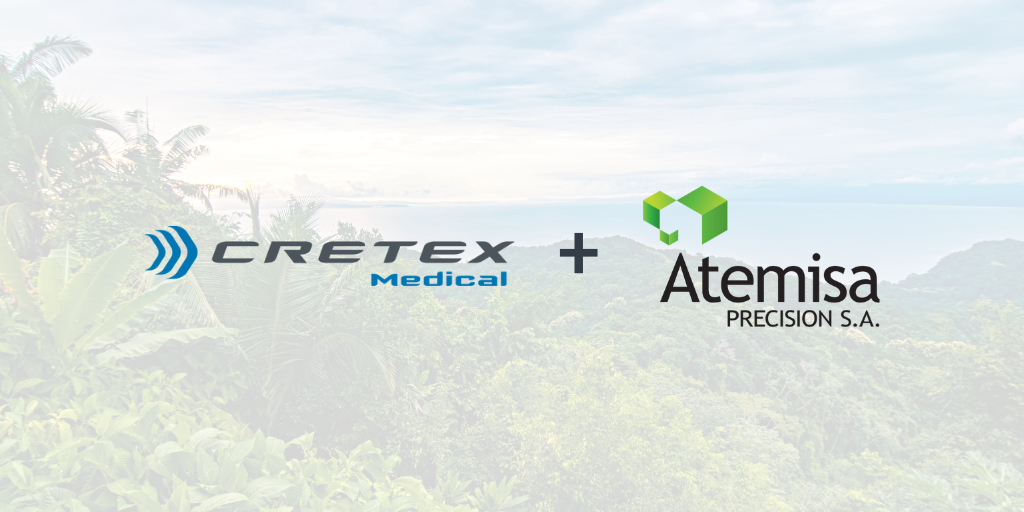The Path to Standardization for AM Medical Products
Cretex Medical | rms has recently established a material testing lab capable of conducting all the standard tests necessary to certify their AM products.
by Medical Manufacturing and Outsourcing | November 10, 2021
Cretex Medical | rms, was featured in Medical Manufacturing and Outsourcing magazine.
It has been nearly 20 years since the first medical devices created via additive manufacturing (AM) have been implanted. In that time, designing and creating prototypes for novel AM medical devices and implants has become rather straightforward. The real challenge in medical additive manufacturing remains the process control and validation requirements that must be met to gain the necessary clearance from the U.S. Food and Drug Administration (FDA). All medical devices must have design and process validations and a quality control strategy. They also must be produced in a facility with a quality management system (QMS) that meets the FDA's stringent requirements for good manufacturing processes (ISO 13485). However, as there are still too few industry-wide standards for AM products, each product typically has a unique set of specifications and process validations. The real challenge in additive manufacturing, then, is not designing the process validations and test methods necessary for each product.
Before Additive Manufacturing
Before additive manufacturing became a viable method for manufacturing utilized long-established specifications for medical device materials and associated test methods necessary to control the production of medical devices and surgical implants. Most of these specifications were created for devices manufactured via traditional methods such as machining. ASTM has a committee (ASTM F4) dedicated to developing and promoting these standards for medical and surgical materials and devices.
Over the years, the FDA has also established guidance documents for process validations and considerations for special processes, an example being their guidance on the testing needs for titanium coatings on medical devices. Unlike additive manufacturing, conventional manufacturing has well-established industry-wide standardization processes that have existed for decades in some cases.
Early Days of Additive Manufacturing
In the early 2000s, when additive manufacturing was in its phase of early adoption, there were no standard practices, test methods, validation strategies, or even general guidance for metal additive manufacturing for medical devices and surgical implants. When possible, AM engineers utilized legacy standards and specifications previously established for conventional machining. However, as the manufacturing methods and materials for these processes are entirely different, the specifications for traditional manufacturing did not lend themselves well to additive manufacturing. This forced device manufacturers and engineers to develop their own set of product-specific specifications and standards for AM parts to supplement the legacy standards. Items included in these product-specific specifications included redefining the meaning of a material lot, rewording necessary microstructural requirements, and specifying location and orientation of quality control coupons for each project.
Many times, early adopters had to make economically unfavorable compromises to ensure product quality while also delivering products to the market in a timely manner. For example, they may not have had time to perform a comprehensive study on the effects of powder reused on the properties of finished products. The manufacturer's specifications would then limit the amount of times powder could be reused based solely on the amount of reuse their pre-launch R&D activities afforded them in lieu of any technical considerations.
During the period of early adoption, the FDA treated additive manufacturing like any other emerging technology. They had materials experts and process control experts for traditional manufacturing, but AM experts did not exist. So, as manufacturers were establishing their own specifications for additive manufacturing, the FDA relied on manufacturers to provide guidance on how to control and monitor AM processes. Soon, however, it became clear that additive manufacturing was going to be larger than the average technological advance. When the FDDA realized additive manufacturing was creating a cultural shift in manufacturing, they saw a need for the development of new guidance documents specifically for this new manufacturing method.
Establishment of ASTM F42 (2009) and the Deployment of FDA AM Guidance
In 2009, ASTM created a committee for additive manufacturing technologies (ASTM F42), which led to the creation of some of the first AM-specific standards. The first standards defined terminology for the AM industry and established several AM material standards. The ASTM F42 committee was created to address the needs of the entire AM community, including industries like aerospace, automotive, and medical. As a result, the AM materials and test method specifications created were very broad to accommodate all members of the community. These specifications had a degree of helpfulness to all industries using additive manufacturing but were not sufficient for any specific industry as it was not possible to include all necessary details for each individual industry.
Since the formation of ASTM F42, the committee has been in the process of developing guidance documents specifically for the medical device industry. A subdivision of ASTM F42 has been created for medical applications (ASTM F42.07.03), which is working on creating medical device-specific terminology, process control protocols, and best practices for processes like powder handling and powder recycling. However, the subcommittee has a long way to go to develop all the specifications necessary to standardize additive manufacturing for the medical industry.
In 2017, the FDA worked with industry experts to release a document titled Technical Considerations for Additive Manufactured Medical Devices. Like ASTM's document, it is broad in scope to accommodate a variety of device types and use factors like patient-matched implants, off-the-shelf devices, instruments, and anatomical models. The document is also comprehensive to cover a variety of processes and materials including both polymers (stereolithography [SLA], selective laser sintering [SLS]) and metals (laser powder-bed fusion [LPBF]). Under this guidance, manufacturers must address considerations such as orientation, build location, powder reuse, and mechanical properties and provide data and justification as to why and how they did or did not include these variables in their design and process validation efforts,
This document allows medical device manufacturers to understand what the FDA expects when submitting a product for clearance. Unfortunately, this document has the same issue as the early ASTM standards. While it lists many factors that need to be considered when testing and establishing a process or product utilizing additive manufacturing, because it is so broad, it cannot delve into the necessary details for each material and process.
Additive Manufacturing Today
Many of the early adopters of additive manufacturing that received FDA clearance on their devices 10 or 15 years ago are now at the point where they are replacing some of their legacy AM products with newly designed products. They are realizing that the path they utilized to gain FDA clearance 10 years ago is not what the FDA expects today. The FDA now has a better understanding of the AM process and has altered their expectations accordingly. Rather than relying on medical device OEMs to provide information, the FDA has formed their own requirements and guidance.
Medical device manufacturers cannot gain FDA approval of their AM devices by relying on outdated regulatory strategies from the early days of additive manufacturing. Today, manufacturers must comply with increasingly stringent specifications and validation requirements. AM devices also see more scrutiny from the FDA compared to traditionally machined devices. The administration looks more closely at the mechanical performance for AM products because with additive manufacturing (specifically LPBF), the geometry and the raw material are created in one process.
While there are an increasing number of AM-specific requirements and specifications being developed, the industry is still lacking sufficient globally accepted standardization. As a result, most manufacturers still rely on internal, independent process and materials specifications to control the quality of their AM products. This complicates workflows for contract manufacturers like rms Company that are manufacturing multiple products for multiple customers, each with its own set of individualized specifications.
Manufacturers must develop quality control test coupons for each product because although the FDA requires manufacturers to produce representative test specimens, it does not provide any additional guidance or standards. Many manufacturers still rely on legacy test methods like ASTM E8 for tensile testing when it does not necessarily apply to what manufacturers are doing with additive manufacturing today. For example, nearly every product that rms additively manufactures has an individual specification detailing how to control the production of the product. Each customer has slightly different testing requirements detailing specimen geometry, quantity, and performance requirements. This requires manufacturers to spend significant engineering resources to develop and validate individual test methods and specifications for each product. Manufacturers must then manage a portfolio of different test methods and perform quality control to the specifications of each product.
Ideally, all products would use the same standardization ASTM document to control their processes when possible. It would be more efficient and cost-effective to use one set of industry-standard specifications rather than having to design and maintain processes for each product individually. Trying to meet these specifications often results in conflicting requirements that each have their own history and context. This adds a layer of difficulty to manufacturing and quality control in an AM production environment.
The last decade has also seen the emergence of new testing and monitoring technologies, which offer additional avenues for AM process and quality control. Advancements in CT scanning have made nondestructive evaluation (NDE) a practical method for high-volume quality control of AM components where before it was mainly limited to a development tool. In-situ melt pool monitoring during the LPBF process is also emerging as a preferred quality control method. Melt pool monitoring is favorable because it provides information about the quality and stability of the process in real-time while the part is being manufactured.
New mechanical test specimens and techniques have recently been created by customers because they represent the products that they are manufacturing better than the general ASTM E8 tensile specimens. However, these new mechanical test specimens are not accepted standardized test methods because there are no established industry-wide standards that dictate how and when those tests should happen.
The AM industry also now has decades of historical data and experience that help eliminate some of the concerns that existed for early adopters. Situations like limited powder reuse and unknowns like machine-to-machine repeatability now have answers that manufacturers can rely on to address concerns the FDA may have.
While progress is being made toward universal standardized test coupons and process validations, there is still a long way to go. AM engineers and manufacturers need to get involved with ASTM and other standardization efforts to help facilitate the development of industry-wise standard specifications.
In the meantime, device designers looking to get their AM products on the market should choose contract manufacturing partners that have experience in dealing with the challenges of AM process control and regulations. Early engagement with AM providers is vital to ensure that the product specifications meet the current expectations of the FDA. With their extensive AM experience, rms Company, for example, can help navigate the regulatory path for the customers. rms has experience managing a portfolio of test methods and a newly established lab that allows them to manage standard and non-standard test methods to support their customers' quality control approaches. An experienced contract manufacturing partner that is familiar with the FDA's expectations is essential to getting AM products cleared and launched successfully.
For more information, visit www.cretexmedical.com.



